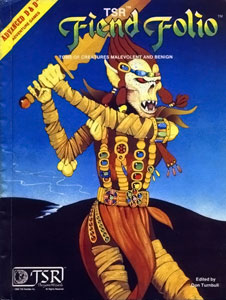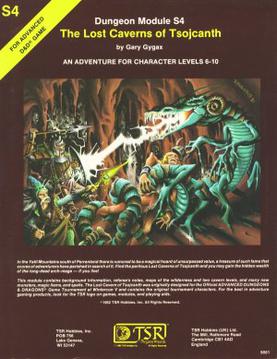Greyhawk, also known as the World of Greyhawk, is a fictional world designed as a campaign setting for the Dungeons & Dragons fantasy roleplaying game. Although not the first campaign world developed for Dungeons & Dragons—Dave Arneson's Blackmoor campaign predated it by about a year—the world of Greyhawk closely identified with early development of the game beginning in 1972, and after being published it remained associated with Dungeons & Dragons publications until 2008. The world itself started as a simple dungeon under a castle designed by Gary Gygax for the amusement of his children and friends, but it was rapidly expanded to include not only a complex multi-layered dungeon environment, but also the nearby city of Greyhawk, and eventually an entire world. In addition to the campaign world, which was published in several editions over twenty years, Greyhawk was also used as the setting for many adventures published in support of the game, as well as for RPGA's massively shared Living Greyhawk campaign from 2000–2008.

TSR, Inc. was an American game publishing company, best known as the original publisher of Dungeons & Dragons (D&D). Its earliest incarnation, Tactical Studies Rules, was founded in October 1973 by Gary Gygax and Don Kaye. Gygax had been unable to find a publisher for D&D, a new type of game he and Dave Arneson were co-developing, so he founded the new company with Kaye to self-publish their products. Needing financing to bring their new game to market, Gygax and Kaye brought in Brian Blume in December as an equal partner. Dungeons & Dragons is generally considered the first tabletop role-playing game (TTRPG), and established the genre. When Kaye died suddenly in 1975, the Tactical Studies Rules partnership restructured into TSR Hobbies, Inc. and accepted investment from Blume's father Melvin. With the popular D&D as its main product, TSR Hobbies became a major force in the games industry by the late 1970s. Melvin Blume eventually transferred his shares to his other son Kevin, making the two Blume brothers the largest shareholders in TSR Hobbies.
Gord the Rogue is the protagonist in a series of fantasy novels and short stories written by Gary Gygax. Gygax originally wrote the novels and short stories to promote his World of Greyhawk campaign setting for the Dungeons & Dragons role-playing game. After he left TSR, Gygax continued to write Gord the Rogue novels for several years. In all of these works, the plot revolves around the adventures of a young man named Gord who rises from humble origins in the slums of a large city on the planet Oerth to become a powerful force trying to stave off the takeover of Oerth by demons.

Fiend Folio is the name of three separate products published for successive editions of the fantasy role-playing game Dungeons & Dragons (D&D). All three are collections of monsters.

Dungeonland (EX1) is a 1983 adventure module for the Dungeons & Dragons (D&D) roleplaying game, written by Gary Gygax for use with the First Edition Advanced Dungeons & Dragons (AD&D) rules. It is an adaptation of Lewis Carroll's 1865 novel Alice's Adventures in Wonderland, with the various characters from the book translated into AD&D terms.

Mordenkainen is a fictional wizard from the World of Greyhawk campaign setting for the Dungeons & Dragons roleplaying game. He was created by Gary Gygax as a player character, only months after the start of Gygax's Greyhawk campaign and is therefore one of the oldest characters continuously associated with Dungeons & Dragons.

Mordenkainen's Fantastic Adventure by Robert J. Kuntz and Gary Gygax is an adventure module for the Dungeons & Dragons role-playing game, published by TSR, Inc. in 1984. It originally bore the code "WG5" and was intended for use with the Advanced Dungeons & Dragons first edition rules. Because it is one of the WG modules, it is a module intended for the World of Greyhawk campaign setting. It was later updated in 2004 to the Third Edition Revised rules in Dungeon magazine, issue #112, as Maure Castle. There were subsequently two additional installments in issues #124 and #139.

The Lost Caverns of Tsojcanth is an adventure module for the Dungeons & Dragons fantasy role-playing game. It was written by Gary Gygax and published by TSR in 1982 for the first edition Advanced Dungeons & Dragons (AD&D) rules. The 64-page adventure bears the code "S4" and is set in the Greyhawk campaign setting. It is divided into two parts, a 32-page adventure, and a 32-page booklet of monsters and magic items. The plot involves the player characters investigating rumors of lost treasure. After traversing a wilderness and two levels of dungeons, the players face Drelnza, the vampiric daughter of long-deceased archmage Iggwilv.

Robert J. Kuntz is a game designer and author of role-playing game publications. He is best known for his contributions to various Dungeons & Dragons-related materials.
Lenard William Lakofka was an American writer of material for the fantasy role-playing game Dungeons & Dragons. Although never a formal employee of TSR, the company that published Dungeons & Dragons, Lakofka was an influential voice in the development of the game. He was one of the playtesters of the game as it was being developed, an editor of early manuscripts, wrote a widely-read monthly D&D magazine column and two official D&D adventures, and had his home campaign setting of the Lendore Isles incorporated into Gary Gygax's World of Greyhawk Fantasy Game Setting.
The World of Greyhawk Fantasy Game Setting and the World of Greyhawk Fantasy World Setting are two closely related publications from TSR, Inc. that detail the fictional World of Greyhawk campaign setting for the Dungeons & Dragons (D&D) fantasy roleplaying game. Both publications were authored by Gary Gygax, and they were the first stand-alone offerings to provide detailed, comprehensive information regarding a D&D campaign setting.
Ian Marsh is a British writer, magazine editor, and entrepreneur.

The Dungeons & Dragons Basic Set is a set of rulebooks for the Dungeons & Dragons (D&D) fantasy role-playing game. First published in 1977, it saw a handful of revisions and reprintings. The first edition was written by J. Eric Holmes based on Gary Gygax and Dave Arneson's original work. Later editions were edited by Tom Moldvay, Frank Mentzer, Troy Denning, and Doug Stewart.
Timothy James Kask is an American editor and writer in the role-playing game industry. Kask became interested in board games in his childhood, and later turned to miniatures wargames. While attending university after a stint in the US Navy, he was part of a group that playtested an early version of the new role-playing game Dungeons & Dragons (D&D) for game co-designer Gary Gygax. Gygax hired him as the first employee of TSR, Inc. in 1975. After editing some of TSR's early D&D publications, Kask became editor of The Strategic Review, which later became The Dragon, and then Dragon Magazine.

The Dungeons & Dragons Companion Set is an expansion boxed set for the Dungeons & Dragons (D&D) fantasy role-playing game. It was first published in 1984 as an expansion to the Dungeons & Dragons Basic Set.

Daredevils is a tabletop role-playing game published by Fantasy Games Unlimited (FGU) in 1982 that is meant to emulate pulp magazine fiction of the 1930s.

Dungeons & Dragons Master Rules is an expansion boxed set for the Dungeons & Dragons (D&D) fantasy role-playing game. It was first published in 1985 as an expansion to the Basic Set.

The Expert Set is an expansion boxed set for the Dungeons & Dragons fantasy role-playing game. It was first published in 1981 as an expansion to the Basic Set.
Don Turnbull was a journalist, editor, games designer, and an accomplished piano and pinball player. He was particularly instrumental in introducing Dungeons & Dragons into the UK, both as the managing director of TSR UK Ltd and as the editor of the Fiend Folio.

DragonLords, subtitled "Yet Another Fantasy & Sci-Fi Roleplaying Magazine", is a British role-playing game fanzine from the late 1970s and early 1980s. Self-published originally by Marc Gascoigne, Mike Lewis, and Ian Marsh, DragonLords produced 22 issues from c. 1978 to 1985.












